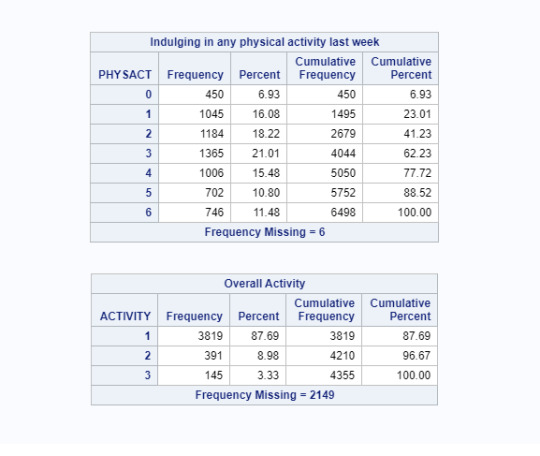Don't wanna be here? Send us removal request.
Text
Creating Graphs
Program

Univariate graphs


Bivariate graphs


From the univariate graphs of individual variables, I can see that most of the adolescents have learnt the importance of exercise in school and most of the children do the physical activities more than 3 times in a week. While seeing the bivariate graphs of both the variables, I could see that even when children did not learn about exercise in school they are indulged in the physical exercises. So there is not direct relationship between the two variables as I thought it would be.
0 notes
Text
Data Management




In this assignment I have excluded the missing data as Frequency Missing. I have also created a new secondary variable called PHYSACT to sum up the variables H1DA5 H1DA6 for the physical activities done by the adolescents.
Then I have grouped the variables values to create a new variable ACTIVITY to determine whether the frequency of doing different activities that the adolescents are doing.
0 notes
Text
My First SAS Program



A random sample of 6,504 adolescents were asked the following questions, Have you learned about the importance of doing exercise in a class at school?
Out of the total number, 92% chose category 2 (yes) means they have learnt the importance of exercising , 7.78% fell under category 1 (no) which means they haven’t learnt about the importance of exercising in school. And a very less people chose 6 and 8 means refused and don’t know.
Another question that was asked was, During the past week, how many times did you do exercise, such as jogging, walking, karate, jumping rope, gymnastics or dancing? Out of total number, 31.66% said 1 or 2 times, 26.89 said 5 or more times, 24.88% said 3 or 4 times, 16.48% said not at all. This means that maximum number of children do their exercises in home as a daily activity.
Another question that was asked was, During the past week, how many times did you play an active sport, such as baseball, softball, basketball, soccer, swimming, or football? Out of 6,504 children, 29.34% replied Not at all, which means they don’t play any sport in daily life. 27.46% said 1 or 2 times, 24.32% said 5 or more times, 18.79% said 3 or 4 times.
0 notes
Text
My First Blog
In process of learning my new course on the Data Management and Visualization. I have learnt what the data sets and code books means and how they are related to each other. For my project i have chosen the AddHealth data set to go on with.
The daily activities of the adolescents
Code Book
Daily Activities
Variables and Descriptions :
H1DA1 how many times did you do work around the house
H1DA2 how many times did you do hobbies
H1DA3 how many times did you watch television or videos, or play video games
H1DA4 how many times did you go roller-blading, roller-skating, skate-boarding, or bicycling
H1DA5 how many times did you play an active sport,
H1DA6 how many times did you do exercise
H1DA7 how many times did you just hang out with friends?
H1DA8 How many hours a week do you watch television
H1DA9 How many hours a week do you watch videos
H1DA10 How many hours a week do you play video or computer games?
H1DA11 How many hours a week do you listen to the radio
Second topic of interest is the things “Taught in school”
While doing a literature review, I saw papers on how stressful the daily activities, school activities and off-school timings are for some children. The sense of control comes into the picture for many girls. Parents tend to force children on doing things that they don’t like to do on a regular basis. As a result they end up doing unmindful things in daily life. Unable to enjoy their favorite hobbies and games , children tend to concentrate less on studies. And vice versa, when children face stress and difficulties in the school, they end up doing nothing in the free time just stressing about their curriculum. Girls tend to sacrifice on their free time activities more than boys. The journal which I went through is “ Boredom, Stress and Social Control in the Daily Activities of Adolescents”.(https://www.tandfonline.com/doi/abs/10.1080/00222216.1996.11949776)
I think the most important thing for school going children is to not take stress and tension from academic pressure and spend quality time for their favorite sports or hobbies that they like to keep them smiling and stress free.
1 note
·
View note